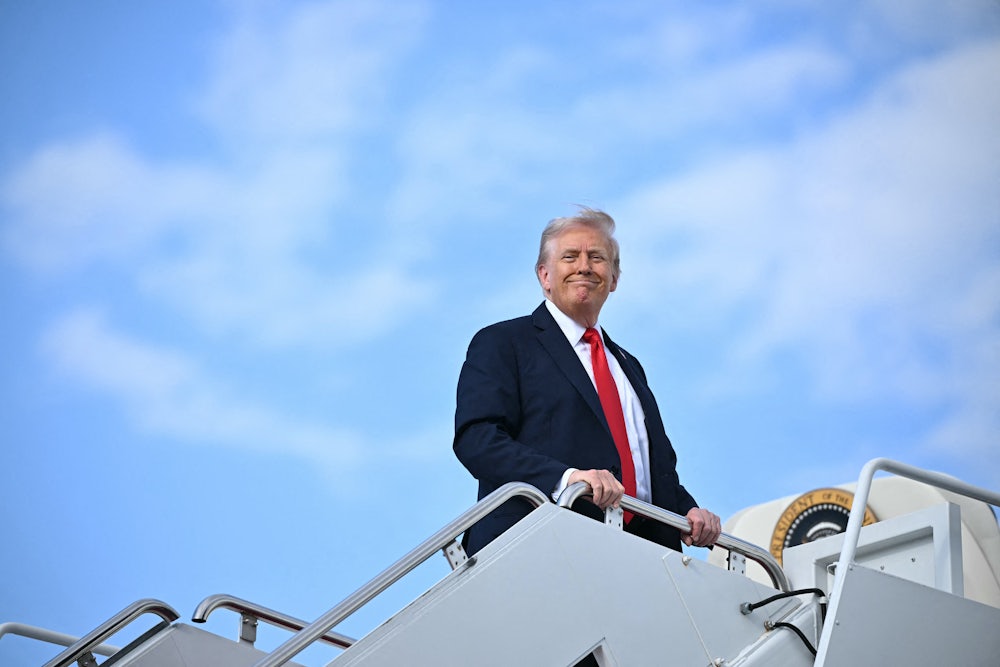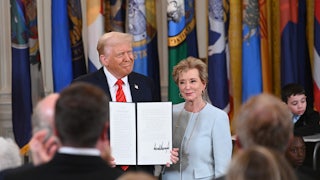Congress is barely functional these days. One reason is that Republicans control both chambers and are consciously ceding their power to President Donald Trump. Other structural factors, like gerrymandering and the constant fundraising churn, have weakened Congress’s ability to pass laws and—as shown by the ongoing shutdown—to keep the government open. But perhaps an even more significant reason is that the Supreme Court’s rulings have rendered it a largely vestigial organ in American governance. With last week’s decision to allow the Trump administration to block $4 billion in appropriated foreign aid, the conservative justices effectively transferred Congress’s spending power to Trump.
The ruling was easily overlooked, one of myriad court decisions this year related to Trump’s norm-smashing, lawbreaking rule. But it’s worth considering the ruling’s ramifications more deeply, as it represents a crippling blow to the American constitutional order—and the further empowerment of Trump as a de facto king.
Department of State v. AIDS Vaccine Advocacy Coalition—I’ll refer to the case hereafter as AVAC, for brevity’s sake—is about the appropriations bill that Congress passed in the spring of 2024. Congress set aside billions of dollars for certain foreign-aid programs at issue in this case. Among those appropriations was $3.9 billion for development assistance, which the law said “shall be made available” for programs and direct relief. AVAC and other groups that regularly receive the funds sued the Trump administration to compel it to take steps to disburse the money.
A federal district court and the D.C. Circuit Court of Appeals sided with those groups, ruling that the administration could not lawfully ignore Congress’s spending powers. That prompted the Trump administration to ask the Supreme Court to intervene once again on the shadow docket. It claimed that the ruling would infringe upon the executive branch’s core powers over foreign affairs. “To have any hope of complying in time, the Executive Branch would have to immediately commence diplomatic discussions with foreign nations about the use of those funds—discussions the President considers counterproductive to foreign policy—and notify Congress about planned obligations that the President is strongly opposing,” they complained.
The groups urged the court to leave the lower court’s order intact. They noted that “neither the injunction nor the appropriations acts require the government to use such agreements to obligate funds,” and emphasized that the lower courts had not told the Trump administration how to spend the funds, only that they must be spent before the deadline. At stake, the plaintiffs warned, was the basic structure of American governance. “The government’s theory that the agencies need not comply with enacted legislation mandating that they spend funds, because the President has unilaterally proposed legislation to rescind those statutory mandates, would fundamentally upend our constitutional structure,” they argued.
In its briefs, the Trump administration took a much different view. It described impoundment—the president’s refusal to spend money appropriated by Congress—as part of the normal “give-and-take of the political process” between the executive and legislative branches. On one side is Congress, which uses its “power of the purse” to “appropriat[e] money for specific programs.” On the other side is the White House, which “has often disagreed about whether and how much of those funds should be spent.”
This is roughly as comprehensive as Beauty and the Beast’s portrayal of prerevolutionary France. Even from the Justice Department’s own description of the matter here, a layperson can tell that only one side has actual constitutional authority, and it is not the president. The brief does emphasize that the executive branch is “vested with exclusive authority to enforce the laws,” as if that amounts to a counterweight of sorts, but those laws are written by Congress.
In reality, there is a broad legal consensus that impoundment is generally unconstitutional. Congress can (and often does) give discretion to presidents on when and how to spend funds, but presidents cannot lawfully or constitutionally refuse to spend funds outright. “It is in our view extremely difficult to formulate a constitutional theory to justify a refusal by the President to comply with a congressional directive to spend,” future Chief Justice William Rehnquist wrote in 1969 in a Justice Department memo for the Nixon administration.
While some executive-legislative “clashes” have happened before, the Trump administration intentionally drew the wrong conclusions from them. President Richard Nixon went far beyond any of his predecessors to impound lawfully appropriated funds, often for vague or political reasons. In 1974, Congress reasserted its power by enacting the Impoundment Control Act, or ICA, to regulate when and how presidents could refuse to spend funds. When presidents deviated from those narrow controls, they could face litigation from the comptroller general, a legislative branch official, on Congress’s behalf.
The Trump administration has long sought to use impoundment to usurp Congress’s spending power. Though it seems like a distant memory now, the House impeached Trump during his first term for withholding congressionally appropriated military aid for Ukraine unless its government falsely accused Joe Biden, his eventual 2020 opponent, of corruption. Russ Vought, Trump’s second-term head of the White House Office of Management and Budget, championed impoundment in Project 2025 as part of his war on the federal government’s basic functions.
In the Trump administration’s apparent view, the ICA is a mechanism by which it can impound funds, and only Congress can stop it. (Republicans on Capitol Hill are more than happy to facilitate that by not overriding the blocks.) AVAC and its allies had sued the Trump administration earlier this year under the Administrative Procedures Act to require it to spend the funds. The Justice Department argued in response that the ICA precluded other laws that allowed the groups to sue it and that only the comptroller general had standing to challenge its refusals to spend money in court.
The conservative justices deferred once again to the Trump administration. “The Government, at this early stage, has made a sufficient showing that the Impoundment Control Act precludes respondents’ suit, brought pursuant to the Administrative Procedure Act, to enforce the appropriations at issue here,” the court wrote in its brief, unsigned order in the case. It also deferred to the administration’s claims that other forms of judicial relief were unavailable.
Justice Elena Kagan, writing in dissent, easily refuted the conservatives’ interpretation of the law by quoting the law itself. “In its very first section, titled ‘Disclaimer,’ the ICA declares: ‘Nothing contained in this Act … shall be construed’ as ‘affecting in any way the claims or defenses of any party to litigation concerning any impoundment,’” she explained, joined by the other two liberal justices. “It is hard to write a clearer and more emphatic non-preclusion provision than that.” (Emphasis hers.)
Just as troubling as the Supreme Court’s sudden bout of illiteracy was its third and final reason for deferring to the executive branch. “On the record before the court, the asserted harms to the Executive’s conduct of foreign affairs appear to outweigh the potential harm faced by respondents,” it claimed. Presidents do have certain powers to represent and negotiate on behalf of the United States, of course, but those powers also have limits.
The Supreme Court closed out its order in AVAC with a formulaic notice. “This order should not be read as a final determination on the merits,” the conservative justices wrote. “The relief granted by the Court today reflects our preliminary view, consistent with the standards for interim relief.”
This, of course, only added insult to injury. Allowing the president to temporarily block funds on September 26 when they expire on September 30 effectively wraps up the entire thing. “The stay the majority grants today suspends that court order,” Kagan said, referring to the lower court instruction to disburse the funds. “The effect is to prevent the funds from reaching their intended recipients—not just now but (because of their impending expiration) for all time.”
While the court might not have been able to stop a ticking clock in this scenario, its instinctive response speaks volumes. The justices ultimately picked the result that would do the most harm. Faced with a choice between long-standing practice and black-letter federal law on one hand and Trump’s vague and abstract policy suggestions on the other, the Supreme Court essentially chose the most lawless path available to it.
This is a recurring theme. Congress created and funded agencies and departments like USAID and the Department of Education; the conservative justices let Trump abolish or largely shutter them without hesitation. Congress said that the president cannot fire the heads of certain multimember independent agencies unless it was for cause; the conservative justices let Trump ignore that law and remove those officials despite a century-old ruling that said otherwise. (The court plans to likely overturn that long-standing precedent on the merits docket later this year.)
Congress also said that the executive branch cannot deport people to third countries where they might face torture and inhumane treatment; the conservative justices greenlit the deportations anyway. The justices even allowed the Trump administration to carry out what are now known as “Kavanaugh stops,” where federal agents can racially profile people and detain them until they learn their immigration status. Kavanaugh described these stops in a concurring opinion as brief, unproblematic encounters that do not violate the Fourth Amendment—something that the Trump administration appears to have gone out of its way to disprove since then.
Indeed, if there is any consistent jurisprudence from the Supreme Court these days, it is this: Trump can do whatever he wants to whomever he wants, except perhaps a member of the Federal Reserve Board of Governors. The Supreme Court ruled this week that Lisa Cook can stay at her post while it decides later this term whether Trump can remove her on pretextual and potentially false grounds. That’s as close as it gets to a defeat for Trump at the high court these days.
In a few weeks, the court will even decide whether Trump can unilaterally raise billions of dollars in tariffs on Americans—a core Article 1 power—through a federal law that does not actually include the word tariff. At this point, why not? If Article 2 lets him stop federal spending on a whim, maybe he can raise taxes on a whim, as well. All that would be left is the ability to set appropriations, and even that is apparently on the table. Trump would have powers undreamt of even by English kings since the Tudors.
This is not what the Constitution’s drafters anticipated after launching a revolution over, among other things, representation for taxation. Nor is it what Americans have known and cherished for the last 250 years from their experiment in self-government. To the six conservative justices on the Supreme Court, apparently, it is time for that experiment to come to an end.






